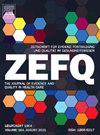Gut und kosteneffektiv palliativ versorgt in Westfalen-Lippe – aber warum? Ergebnisse einer Mixed-Methods Studie
IF 1.7
Q4 HEALTH POLICY & SERVICES
Zeitschrift fur Evidenz Fortbildung und Qualitaet im Gesundheitswesen
Pub Date : 2025-09-01
DOI:10.1016/j.zefq.2025.06.001
引用次数: 0
Abstract
Background
The organization of palliative care in Germany varies from region to region. Previous studies show that palliative care in Westphalia-Lippe (WL) – measured by quality and cost indicators – performs better than in other regions. The Westphalian model for outpatient care emphasizes a close cooperation between general practitioners (GPs) and palliative care consultation services (PCS). The basis is a contractual regulation of general and specialized care within a joint outpatient palliative care contract according to Sect. 140a SGB V. The VESPAL study (on the Quality of care in outpatient palliative care based on the example of Westphalia-Lippe), which was funded by the Professional Association of Palliative Care Physicians in Westfalen-Lippe (Berufsverband der Palliativmediziner in Westfalen-Lippe e.V.) and the Association of Statutory Health Insurance Physicians (Kassenärztliche Vereinigung Westfalen-Lippe e.V.), was conducted between 02/2022 and 07/2023 and examined which characteristics of outpatient palliative care in WL could be identified from the correlation of quantitative key figures with qualitative interview quotes that might contribute to high-quality care and cost-effectiveness.
Methods
A complex mixed-methods design was applied. Quantitative and qualitative data were collected and analyzed simultaneously, were used as a basis for further qualitative research, and then merged (QUAL+QUAN → QUAL). The quantitative data were derived from a routine data analysis on the utilization and quality of palliative care from data of deceased patients who had been covered by the BARMER health insurance, while qualitative data were obtained using five non-participant observations, interviews with 50 care providers (general practitioners, palliative care physicians, coordinators, nurses), and three focus groups. Both data sets were analyzed independently, with the quantitative results being complemented by qualitative insights to provide a more comprehensive understanding of the WL care model.
Results
The quantitative parameters used to measure the quality of care included, in particular: the hospital as place of death, the number of hospital cases, and the number of ambulance call-outs in the last 30 days of life. The qualitative study results show that these parameters can be improved by a close cooperation and specific arrangements with emergency services and nursing homes. According to the interviewees, the typical Westphalian organization of cooperation between doctors and PCS enables providers to respond quickly and provide care which is focused on the needs of patients and their relatives and can be flexibly “ramped up and down”. Providers emphasized the flexibility of the model, the close cooperation, and the lack of competitive pressure from each other as reasons for the high quality of care perceived.
Conclusions
The results provide concrete indications of the potential mechanisms that are effective in the widespread WL outpatient model and which might explain the high quality of care and its cost-effectiveness. Future studies should address questions of transferability to other regions.
[威斯特伐利亚-利佩的良好且具有成本效益的姑息治疗-但为什么?]混合方法研究的结果]。
背景:在德国,姑息治疗的组织因地区而异。以前的研究表明,威斯特伐利亚-利佩(WL)的姑息治疗——以质量和成本指标衡量——比其他地区表现更好。威斯特伐利亚模式的门诊护理强调全科医生(全科医生)和姑息治疗咨询服务(PCS)之间的密切合作。其基础是根据SGB V. 140a节,在联合门诊姑息治疗合同中对一般护理和专科护理的合同规定。VESPAL研究(基于威斯特伐利亚-利佩的门诊姑息治疗的护理质量)。由威斯特法伦-利普姑息治疗医师专业协会(Berufsverband der Palliativmediziner in Westfalen-Lippe e.v.)和法定健康保险医师协会(Kassenärztliche Vereinigung Westfalen-Lippe e.v.)资助,在2022年2月至2023年7月期间进行了一项研究,研究了从定量关键数据与定性访谈引用的相关性中可以识别出WL门诊姑息治疗的哪些特征,这些特征可能有助于提供高质量的护理和成本效益。方法:采用复杂的混合方法设计。定量和定性数据同时收集和分析,作为进一步定性研究的基础,然后合并(QUAL+QUAN→QUAL)。定量数据来自BARMER健康保险覆盖的已故患者数据中关于姑息治疗的利用和质量的常规数据分析,而定性数据通过5次非参与性观察、对50名护理提供者(全科医生、姑息治疗医生、协调员、护士)和3个焦点小组的访谈获得。两个数据集都被独立分析,定量结果与定性见解相辅相成,以提供对WL护理模式更全面的了解。结果:用于衡量护理质量的定量参数包括,特别是:医院作为死亡地点,医院病例数和生命最后30天的救护车呼叫次数。定性研究结果表明,通过与急救服务和养老院的密切合作和具体安排,这些参数可以得到改善。根据受访者的说法,典型的威斯特伐利亚式医生和PCS之间的合作组织使提供者能够快速响应,并提供专注于患者及其亲属需求的护理,并且可以灵活地“上下起伏”。提供者强调了模式的灵活性,密切合作,以及彼此之间缺乏竞争压力,这些都是高质量护理的原因。结论:结果提供了在广泛的WL门诊模式中有效的潜在机制的具体指示,这可能解释了高质量的护理和成本效益。今后的研究应解决可转移到其他区域的问题。
本文章由计算机程序翻译,如有差异,请以英文原文为准。
求助全文
约1分钟内获得全文
求助全文
来源期刊

Zeitschrift fur Evidenz Fortbildung und Qualitaet im Gesundheitswesen
HEALTH POLICY & SERVICES-
CiteScore
1.90
自引率
18.20%
发文量
129
 求助内容:
求助内容: 应助结果提醒方式:
应助结果提醒方式:


